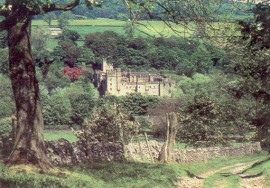Review of ‘Peakland Roads & Trackways’, by A.E. & E.M. DoddThis review is by Julie Bunting, and was published originally in The Peak Advertiser, the Peak District's local free newspaper, on 18th December 2000, and is reproduced with Julie's kind permission.
Lindsey Porter of Landmark Publishing describes the Dodds, husband and wife, as having been 'devoted to the Peak and devoted to each other'. The couple wrote Peakland Roads and Trackways in their retirement at Ellastone. Arthur Dodds died in 1990 and Molly about five years later. In identifying and re-treading the routes of prehistoric tracks and ancient highways the authors missed nothing, from clues in old documents to the tangible - guide stones, former toll cottages, bridges and fords ('keeping feet dry in the colder wetter times ... was always important') and things that a less keen eye might never have noticed. The Dodds' style of writing, whilst authoritative, holds one's interest right through the book, especially where they create pictures of scenes which brought the roads and trackways into being: the Rushup Edge ridgeway route - used for at least 4,000 years, connections linking prehistoric henges, the transport of tools and weapons of Irish bronze, Roman roadbuilders improving rough tracks for the movement of their troops, the days of coach travel and mail deliveries, packhorses and drovers and, finally, motor travel. Numerous old documents contain references to the 'foul' roads of the Peak; the best used were, of course, reduced to the worst condition but their importance ensured that many have remained in use to the present day, and thereby we find a few surprises. By contrast others like the ancient Chariot Way are now broad green lanes. A wonderful picture emerges of the road measuring method used by John Ogilvy in 1675 in preparation for his strip maps, on which each mile was numbered. We pass by places named Bellyband Grange, Wythen Lache, Bottom-of-the-Oven and Bareleg Hill, and are told of a time when Alstonefield had a market, or tiny Aldwark received enough travellers to support four inns. There will always be unsolved mysteries in a region where much of the land has been destroyed by lead mining but this new publication will hopefully follow in the footsteps of its predecessor by spurring on the completion of further work. Two notes of alarm should be heeded; new photographs in the book show how inscriptions on old guideposts have deteriorated in the last twenty-five years, and other photographs bear witness to the continuing destruction by motor bike scramblers of paved packhorse roads, surely worthy of protection as ancient monuments. Landmark Publishing has produced a superb new version of a true classic, with amendments based on fresh research, field work and archaeological excavations. With the addition of colour photographs and fifty redrawn maps this 190-page hardback edition will be inspirational to a new generation, particularly those who explore the Peak on foot. Review by Julie Bunting |
|||
